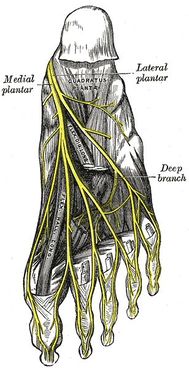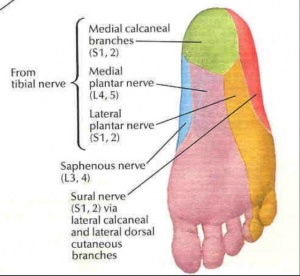Lateral Plantar Nerve: Difference between revisions
Leana Louw (talk | contribs) No edit summary |
No edit summary |
||
| Line 6: | Line 6: | ||
== Description == | == Description == | ||
The lateral plantar nerve or the external plantar nerve ''(latin: nervus plantaris lateralis),'' it enters the sole of the [[Foot Anatomy|foot]] by passing deep to the proximal insertion of the abductor hallucis muscle. It continues across the sole anteriorly and laterally, between the digitorum brevis and quadratus plantae muscles inervating both of this muscles. Then, close to the 5th metatarsal head it will divide into the deep and superficial branches.[[File:Gray833 (1).jpg|thumb|368x368px]] | |||
=== Root: === | |||
is a terminal branch of the [[Tibial Nerve|tibial nerve]] | |||
=== | === Branches: === | ||
* Superficial branch of the lateral plantar nerve splits into: | |||
** The lateral proper plantar digital nerve, which inervates the skin of the lateral aspects of the 5th toe and a branch for inervating the flexor digiti quinti brevis. | |||
** The common plantar digital nerve which communicates with the 3rd common branch of the [[Medial Plantar Nerve|medial plantar nerve]] and divides into the two proper digital nerves of the 4th and 5th toe. | |||
* Deep branch of the lateral plantar nerve; is a motor branch and it inervates from the second to the fourth lumbricales, the adductor hallucis, and supplies all the interossei (appart from the ones on the 4th metatarsal space inervated by the superficial branch). | |||
== Function == | == Function == | ||
[[File:Plantar Nerve Innervation.jpg|thumb]] | |||
=== Motor === | === Motor === | ||
It is a motor nerve which inervates all the intrinsic muscles from the sole with the exception of abductor hallucis, flexor digitorum brevis, the flexor hallucis brevis and the first lumbrical muscle inervated by the [[Medial Plantar Nerve|medial plantar nerve]]. | |||
=== Sensory === | === Sensory === | ||
It also a sensory nerve which provides sensory information from the two anterior thirds of the lateral sole of the foot, as well as the plantar surfaces for the 5th and half of the 4th toe. | |||
== Clinical relevance == | == Clinical relevance == | ||
The clinical relevance, the entrapement of the lateral plantar nerve first branch, also known as Baxter's nerve has symptoms similar to [[Plantar Fasciitis|plantar fasciitis]] and [[Tarsal Tunnel Syndrome|tarsal tunnel syndrome]] including pain at the inside of the ankle and heel. Baxter's Neuropathy,is the entrapement of the first branch of the lateral plantar nerve, which inervates the abductor digiti quinti muscle. The Baxter's Neuropathty is a painful condition that can lead to chronic heel pain. | |||
== Assessment | == Assessment<ref>Thomas, J. L., Christensen, J. C., Kravitz, S. R., Mendicino, R. W., Schuberth, J. M., Vanore, J. V., et all. The diagnosis and treatment of heel pain: a clinical practice guideline-revision . ''[https://pubmed.ncbi.nlm.nih.gov/20439021/ The Journal of foot and ankle surgery : official publication of the American College of Foot and Ankle Surgeons]''[https://pubmed.ncbi.nlm.nih.gov/20439021/ ,] 2010, ''49''(3 Suppl), S1–S19. <nowiki>https://doi.org/10.1053/j.jfas.2010.01.001</nowiki></ref><ref name=":0">Ferkel, E., Davis, W. H., & Ellington, J. K. . [https://pubmed.ncbi.nlm.nih.gov/26409596/ Entrapment neuropathies of the foot and ankle.] ''Clinics in sports medicine'', 2015, ''34''(4), 791-801.</ref> == | ||
Baxter's Neruopathy: | Baxter's Neruopathy: | ||
| Line 54: | Line 38: | ||
* There may be a positive Tinel’s sign. Paresthesias may be reproduced with tapping over the nerve beneath the abductor hallucis muscle. | * There may be a positive Tinel’s sign. Paresthesias may be reproduced with tapping over the nerve beneath the abductor hallucis muscle. | ||
* In chronic cases, patients may have diminished sensation in the lateral plantar foot. | * In chronic cases, patients may have diminished sensation in the lateral plantar foot. | ||
Treatment:<ref>Davis PF, Severud E, Baxter DE. [https://pubmed.ncbi.nlm.nih.gov/7834059/ Painful heel syndrome: results of nonoperative treatment]. ''Foot Ankle Int''. 1994;15(10):531-535. doi:10.1177/107110079401501002</ref><ref>Lui, T. H. . [https://link.springer.com/article/10.1007/s00402-007-0380-1#citeas Endoscopic decompression of the first branch of the lateral plantar nerve]. ''Archives of Orthopaedic and Trauma Surgery'',2007 ''127''(9), 859-861.</ref> | == Treatment:<ref name=":0" /> <ref>Davis PF, Severud E, Baxter DE. [https://pubmed.ncbi.nlm.nih.gov/7834059/ Painful heel syndrome: results of nonoperative treatment]. ''Foot Ankle Int''. 1994;15(10):531-535. doi:10.1177/107110079401501002</ref><ref>Lui, T. H. . [https://link.springer.com/article/10.1007/s00402-007-0380-1#citeas Endoscopic decompression of the first branch of the lateral plantar nerve]. ''Archives of Orthopaedic and Trauma Surgery'',2007 ''127''(9), 859-861.</ref> == | ||
* Conservative treatment includes | * Conservative treatment includes | ||
# Taping and/or orthotics to control overpronation. | # Taping and/or orthotics to control overpronation. | ||
| Line 64: | Line 48: | ||
Endoscopic decompression of the first branch of the lateral plantar nerve | Endoscopic decompression of the first branch of the lateral plantar nerve | ||
References | == References == | ||
<references /> | |||
[[Category:Anatomy]] | |||
[[Category:Nerves]] | |||
__NEWSECTIONLINK__ | __NEWSECTIONLINK__ | ||
| Line 71: | Line 61: | ||
[[Category:Foot - Anatomy]] | [[Category:Foot - Anatomy]] | ||
[[Category:Neuropathy]] | [[Category:Neuropathy]] | ||
Revision as of 20:07, 21 September 2020
Top Contributors - Elena Ferrero Vila, Leana Louw and Wendy Snyders
Description[edit | edit source]
The lateral plantar nerve or the external plantar nerve (latin: nervus plantaris lateralis), it enters the sole of the foot by passing deep to the proximal insertion of the abductor hallucis muscle. It continues across the sole anteriorly and laterally, between the digitorum brevis and quadratus plantae muscles inervating both of this muscles. Then, close to the 5th metatarsal head it will divide into the deep and superficial branches.
Root:[edit | edit source]
is a terminal branch of the tibial nerve
Branches:[edit | edit source]
- Superficial branch of the lateral plantar nerve splits into:
- The lateral proper plantar digital nerve, which inervates the skin of the lateral aspects of the 5th toe and a branch for inervating the flexor digiti quinti brevis.
- The common plantar digital nerve which communicates with the 3rd common branch of the medial plantar nerve and divides into the two proper digital nerves of the 4th and 5th toe.
- Deep branch of the lateral plantar nerve; is a motor branch and it inervates from the second to the fourth lumbricales, the adductor hallucis, and supplies all the interossei (appart from the ones on the 4th metatarsal space inervated by the superficial branch).
Function[edit | edit source]
Motor[edit | edit source]
It is a motor nerve which inervates all the intrinsic muscles from the sole with the exception of abductor hallucis, flexor digitorum brevis, the flexor hallucis brevis and the first lumbrical muscle inervated by the medial plantar nerve.
Sensory[edit | edit source]
It also a sensory nerve which provides sensory information from the two anterior thirds of the lateral sole of the foot, as well as the plantar surfaces for the 5th and half of the 4th toe.
Clinical relevance[edit | edit source]
The clinical relevance, the entrapement of the lateral plantar nerve first branch, also known as Baxter's nerve has symptoms similar to plantar fasciitis and tarsal tunnel syndrome including pain at the inside of the ankle and heel. Baxter's Neuropathy,is the entrapement of the first branch of the lateral plantar nerve, which inervates the abductor digiti quinti muscle. The Baxter's Neuropathty is a painful condition that can lead to chronic heel pain.
Assessment[1][2][edit | edit source]
Baxter's Neruopathy:
- The symptoms are usually pain at the medial aspect of the heel that exponentially increases with loadberaing.
- Symptoms tend to get worse as the day goes on , or appering after prolonged activity.
- A radiating pain may be present when the nerve is palpated.
- There is maximal tenderness at the medial border of the heel where the entrapment occurs – usually around the origin and deep to the abductor hallucis. This may create radiating and/or burning pain laterally across the plantar foot.
- There is a positive Phalen’s test (invert and plantarflex the foot passively). This compresses the nerve due to narrowing of the porta pedis
- There may be weak abduction of the fifth toe. This is due to the abductor digiti minimi muscle.
- There may be a positive Tinel’s sign. Paresthesias may be reproduced with tapping over the nerve beneath the abductor hallucis muscle.
- In chronic cases, patients may have diminished sensation in the lateral plantar foot.
Treatment:[2] [3][4][edit | edit source]
- Conservative treatment includes
- Taping and/or orthotics to control overpronation.
- Stretching of the soleus and gastrocnemius muscles.
- Soft tissue therapy to the plantar fascia and foot intrinsic.
- No steroidal anti-inflammatory medication (NSAIDS).
- Strengthening exercises for the foot intrinsics.
- Non-conservative treatment:
Endoscopic decompression of the first branch of the lateral plantar nerve
References[edit | edit source]
- ↑ Thomas, J. L., Christensen, J. C., Kravitz, S. R., Mendicino, R. W., Schuberth, J. M., Vanore, J. V., et all. The diagnosis and treatment of heel pain: a clinical practice guideline-revision . The Journal of foot and ankle surgery : official publication of the American College of Foot and Ankle Surgeons, 2010, 49(3 Suppl), S1–S19. https://doi.org/10.1053/j.jfas.2010.01.001
- ↑ 2.0 2.1 Ferkel, E., Davis, W. H., & Ellington, J. K. . Entrapment neuropathies of the foot and ankle. Clinics in sports medicine, 2015, 34(4), 791-801.
- ↑ Davis PF, Severud E, Baxter DE. Painful heel syndrome: results of nonoperative treatment. Foot Ankle Int. 1994;15(10):531-535. doi:10.1177/107110079401501002
- ↑ Lui, T. H. . Endoscopic decompression of the first branch of the lateral plantar nerve. Archives of Orthopaedic and Trauma Surgery,2007 127(9), 859-861.








